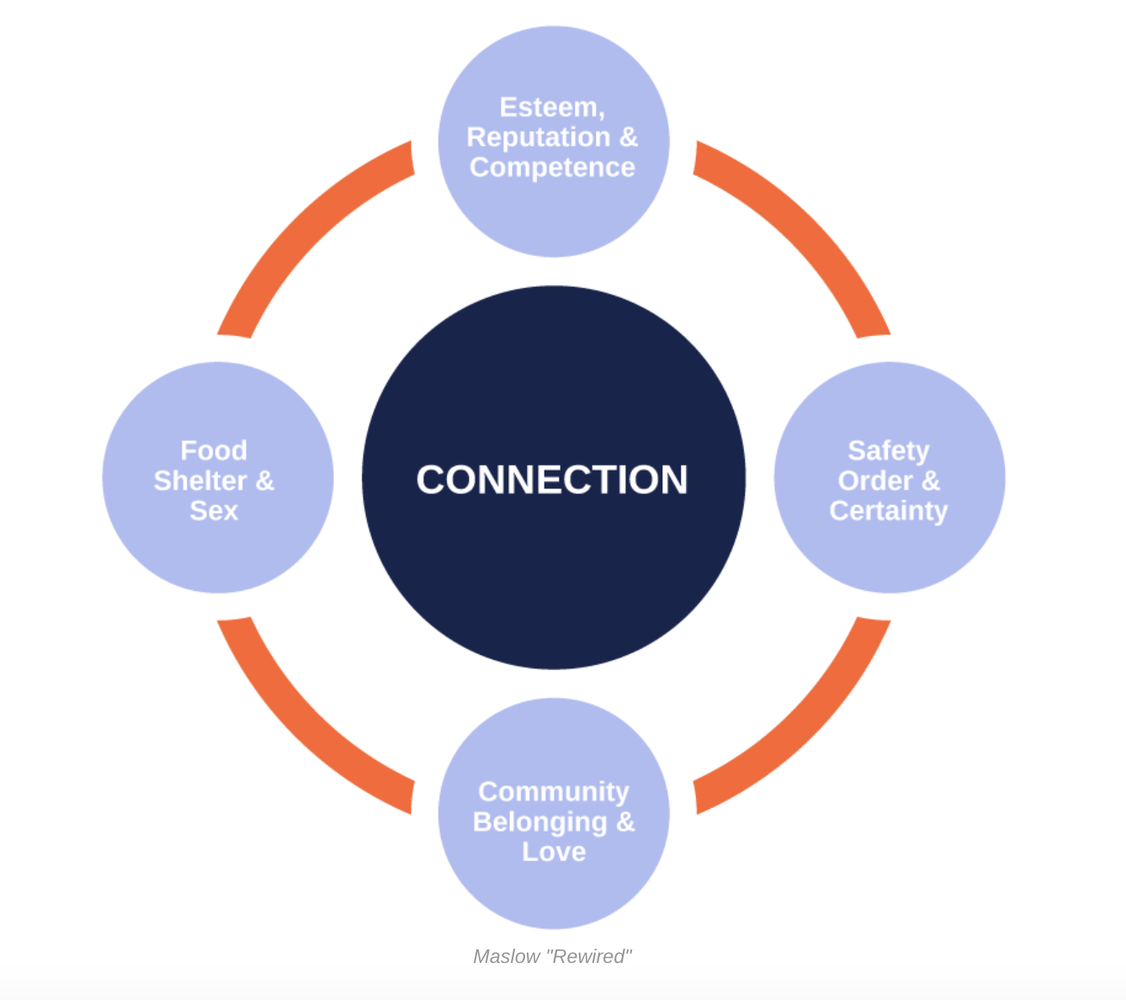Creating belonging and connection has become a top agenda item for companies since the pandemic. The shift to remote or hybrid environments took away those seemingly automatic connections being made around ‘the water cooler’ when everyone was in an office. Leaving leaders and HR managers at the forefront of the conversation on how to create a sense of belonging and connection for everyone - no matter where people are working. But like many aspects of life, there isn’t a straightforward answer.
Everyone is different and has different expectations from work. Which begs the question, should this responsibility solely fall on a leader to create belonging?
Most of you have probably heard about Maslow’s hierarchy of five needs, separated into three categories of basic needs, psychological needs and then self-fulfilment needs. Stephen Denning, an advocate for placing social connection at the core of Maslow’s needs, explains that while Maslow’s pyramid may have suited the 20th century traditional top-down management structure, in today’s world of hyper connectivity and empowered employees, a different more overlapping style of leadership is needed. No matter a pyramid or circle shape, our needs all fall on a spectrum of varying degrees of importance. Can we separate our personal needs from our workplace needs? Are they actually different?

Meet Alex, the newest team member of a large and growing remote–based company. In the initial stages of Alex’s career, his focus was on meeting his basic physiological and safety needs – a stable job, financial security, and a conducive work environment. However, recently, Alex had been seeking not just professional success but also a sense of purpose, belonging and connection in his work. Based on what the company shared on its website around values and vision, Alex expected that this new job may fulfill these elements he had been searching for.
According to the EY Belonging Barometer 3.0, almost half (41%) of respondent workers at companies across the globe say that their workplace is where they feel the greatest sense of belonging, second to home. Yet 75% report having felt excluded at work. Although Alex’s company provided perks and the usual standard company requirements, it was still devoid of genuine camaraderie and connection for him. He didn’t feel a sense of belonging and his enthusiasm for the new role started to wane. What now?
I believe that creating a sense of belonging at work is a shared responsibility that involves both leaders and individuals within the organisation.
- Set the Tone: Demonstrate inclusivity and respect. Foster a workplace culture where everyone feels valued and heard.
- Mandate Inclusive Policies: Implement inclusive policies and practices, such as diversity training, mentorship programmes, and flexible work arrangements.
- Communicate: Encourage dialogue, address concerns promptly, and actively seek input from employees.
- Recognise and Appreciate: Make employees feel valued and acknowledged. Download our free guide for ideas on how to appreciate your employees remotely.
- Address Disparities: Address any disparities in belonging related to different demographic groups. Ensure everyone feels heard and seen.
Empty space, drag to resize
- Actively Engage: Participate in team activities, engage in discussions, contribute to social channels.
- Support Colleagues: Offer to help colleagues, especially newcomers or those going through a challenging season.
- Embrace Diversity: Stay open-minded, respectful, and inclusive in interactions.
- Seek Feedback: Giving and receiving feedback helps in building trust and mutual respect.
- Celebrate: Share each other’s wins, birthdays, big milestones!
Empty space, drag to resize
It would be easy to think that remote work is why we’re not feeling as connected as we once were. But a recent
international survey investigated the impact of workspace on employees’ self-reported sense of belonging at work and “found that workspace did not have a significant impact on surveyed employees’ feelings of belonging at work.” Their findings suggest that for most employees, organisational culture and climate are likely more important than physical workspace when it comes to whether employees feel they belong.
At this point, Alex could throw in the towel and start looking for the next opportunity again. Or he could dig a little deeper into his own needs, expectations, and where the misalignment is coming from. His manager can check in with him, but he can also check-in with his manager.
Organisational culture is a reflection of leadership. A leader’s values and beliefs influence the culture of an organisation. While they should and can be co-created with employees, to some extent, it is also important for a leader to be clear on what these are, how they translate into behaviour, recognition and ways of leading. The more explicit and true to the written word, the easier it is for an individual to assess culture-fit and in turn a sense of belonging.
- Is creating a sense of belonging important to you?
- What does connection look like in your company?
- Do you understand what belonging means to your team?
- If so, how do you currently foster it?
- What could you do to stop/start or keep to create more belonging and connection?
Onward and upward,
Jackie
If you’d like to chat more about creating belonging and connection in your team or if you're ready to learn about our LeadMe Academy Leadership & Coaching Programme, you can connect with me on email me at jackie@leadme.academy



